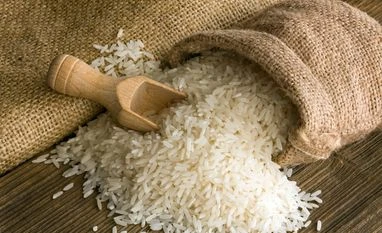The Centre’s move over the weekend to lift curbs on export of non-basmati white rice and replace it with a minimum export price (MEP) of $490 per tonne is to ensure that cheaper rice varieties for PDS consumption are not exported out of India, trade and market sources said.
This will also lift the export of premium varieties such as ‘Sona Masuri’ and ‘Gobindo Bhog.’
Export tax on non-basmati white rice was also slashed just a day before the MEP was imposed by the government.
‘Gobindo Bhog’ and ‘Sona Masuri’ rice varieties are among the premium non-basmati rice variants priced at over $600 per tonne in the global markets.
The second decision also taken over the weekend was on lowering the export duty on parboiled rice from the current
20 per cent to 10 per cent. This will make Indian varieties competitive against their nearest challengers from Thailand, the market participants added.
Prices of Thailand’s 100 per cent premium parboiled rice have dropped from around $604 per tonne on September 4 to around $583 per tonne on September 25. This is a fall of almost 4 per cent in less than a month.
Indian parboiled rice with 20 per cent export duty was selling at close to $570-600 per tonne.
And, with the reduction in export tax now, it will be priced at par with its Thai competitor.
India usually sells parboiled rice with 5-25 per cent broken content, said traders.
The Centre, besides lowering export tax on paddy from 20 per cent to 10 per cent, also lowered tax on brown rice in the same proportion. The traders said this will ensure that exports to countries such as Nepal get cheaper and smooth.
However, export of broken rice has not been relaxed which traders said could ensure their easy availability (and cheap) for the domestic grain-based ethanol manufacturers. This is also true for poultry traders, who are among the major consumers of broken rice in the country.
India usually exports basmati and non-basmati rice. And, within the non-basmati category, the most common forms are broken rice, parboiled rice, and white or raw rice.
FY23 by many counts is considered a standout year for rice exports from India.
The country in total exported around 22.33 million tonnes of rice of which basmati rice was around 4.55 million while non-basmati rice was around 17.78 million.
Within the non-basmati category, broken rice exports were to the tune of around 3-4 million tonnes while parboiled
rice and white rice comprised the rest in near equal proportion.
However, in FY24, total rice exports dropped 16.35 million tonnes, a fall of almost 27 per cent, as the non-basmati segment suffered more due to the curbs imposed by the government.
Now, with rice production in the kharif season looking healthy and Food Corporation of India (FCI) sitting on a huge stockpile, and given the coming elections in major rice-growing states of Haryana and Jharkhand, the Centre has eased some of the curbs to bolster exports.
Coming to the question of replacing the duty with MEP of $490 per tonne on white rice, traders said that when converted to rupees it comes to around Rs 2,747 per quintal for paddy (unmilled rice).
The minimum support price (MSP) of common grade paddy for the 2024-25 season is fixed at Rs 2,300 per quintal.
This clearly shows that the new MEP will not allow cheap rice to move out of India, while farmers will get their due MSP and inflation controlled.
The actual cost for an exporter of the same rice after adding all charges is around Rs 4,326 per quintal.
“The backward calculation of MEP provides an insight that it is set in line with MSP. Therefore, MEP guarantees income for the rice farmers. The Thai export price has significantly fallen during the last few months. Based on white rice MEP, Thai rice export price will further fall and bring equilibrium in the global prices. This will nullify the arbitrage between Indian and Thai prices.
Therefore, opening up of raw or white rice export may not increase the domestic price in the current scenario,” said S. Chandrasekaran, a leading trade policy analyst and author of the book ‘Basmati Rice: The Natural History Geographical Indication.’
Unlock 30+ premium stories daily hand-picked by our editors, across devices on browser and app.
Pick your 5 favourite companies, get a daily email with all news updates on them.
Full access to our intuitive epaper - clip, save, share articles from any device; newspaper archives from 2006.
Preferential invites to Business Standard events.
Curated newsletters on markets, personal finance, policy & politics, start-ups, technology, and more.
)